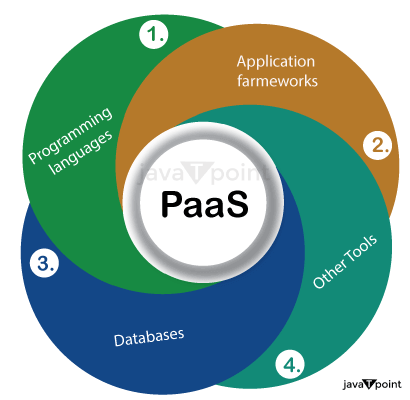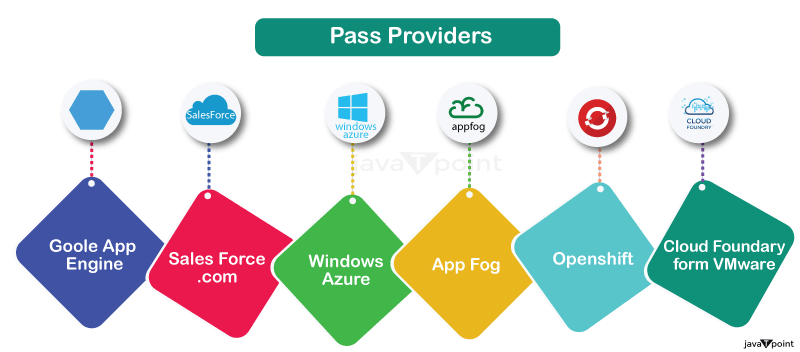Platform as a Service | PaaSPlatform as a Service (PaaS) provides a runtime environment. It allows programmers to easily create, test, run, and deploy web applications. You can purchase these applications from a cloud service provider on a pay-as-per-use basis and access them using an Internet connection. In PaaS, back-end scalability is managed by the cloud service provider, so end-users do not need to worry about managing the infrastructure. 
PaaS includes infrastructure (servers, storage, and networking) and platform (middleware, development tools, database management systems, business intelligence, and more) to support the web application life cycle. Examples: Google App Engine, Force.com, Joyent, Azure. Some of the Services Provided by PaaS are:Programming Languages: A variety of programming languages are supported by PaaS providers, allowing developers to choose their favorite language to create apps. Languages including Java, Python, Ruby,.NET, PHP, and Node.js are frequently supported. Application Frameworks: Pre-configured application frameworks are offered by PaaS platforms, which streamline the development process. These frameworks include features like libraries, APIs, and tools for quick development, laying the groundwork for creating scalable and reliable applications. Popular application frameworks include Laravel, Django, Ruby on Rails, and Spring Framework. Databases: Managed database services are provided by PaaS providers, making it simple for developers to store and retrieve data. These services support relational databases (like MySQL, PostgreSQL, and Microsoft SQL Server) and NoSQL databases (like MongoDB, Cassandra, and Redis). For its database services, PaaS platforms often offer automated backups, scalability, and monitoring tools. Additional Tools and Services: PaaS providers provide a range of extra tools and services to aid in the lifecycle of application development and deployment. These may consist of the following:
Because of the services offered by PaaS platforms, developers may concentrate on creating applications rather than worrying about the infrastructure, middleware, or database management that supports them. A streamlined and effective environment is provided by PaaS for developing, deploying, and managing applications. Development and Deployment Tools:For the creation and deployment of software applications, Platform as a Service (PaaS) provides a vast array of tools, libraries, and services. The following are some of the essential tools and services that PaaS companies provide:
In conclusion, PaaS provides a variety of instruments, resources, and services to aid in the creation and distribution of software applications. Development, database administration, deployment, integration with outside services, analytics and monitoring, and security tools and services are some of the tools that fall under this category. Developers can build, test, deploy, and manage their apps on a complete platform provided by PaaS providers without the need for complicated infrastructure. Advantages of PaaSThere are the following advantages of PaaS - 1) Simplified Development PaaS allows developers to focus on development and innovation without worrying about infrastructure management. 2) Lower risk No need for up-front investment in hardware and software. Developers only need a PC and an internet connection to start building applications. 3) Prebuilt business functionality Some PaaS vendors also provide already defined business functionality so that users can avoid building everything from very scratch and hence can directly start the projects only. 4) Instant community PaaS vendors frequently provide online communities where the developer can get ideas, share experiences, and seek advice from others. 5) Scalability Applications deployed can scale from one to thousands of users without any changes to the applications. Disadvantages of PaaS Loud Computing Layer1) Vendor lock-in One has to write the applications according to the platform provided by the PaaS vendor, so the migration of an application to another PaaS vendor would be a problem. 2) Data Privacy Corporate data, whether it can be critical or not, will be private, so if it is not located within the walls of the company, there can be a risk in terms of privacy of data. 3) Integration with the rest of the systems applications It may happen that some applications are local, and some are in the cloud. So there will be chances of increased complexity when we want to use data in the cloud with the local data. 4) Limited Customization and Control: The degree of customization and control over the underlying infrastructure is constrained by PaaS platforms' frequent provision of pre-configured services and their relative rigidity. Organizations can evaluate the viability of PaaS solutions for their unique requirements by taking into account these characteristics, as well as the trade-offs and potential difficulties involved in implementing such platforms. Popular PaaS ProvidersThe below table shows some popular PaaS providers and services that are provided by them - 
Next TopicSoftware as a Service | SaaS
|
 For Videos Join Our Youtube Channel: Join Now
For Videos Join Our Youtube Channel: Join Now
Feedback
- Send your Feedback to [email protected]
Help Others, Please Share










